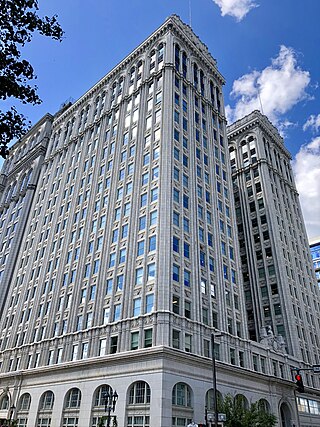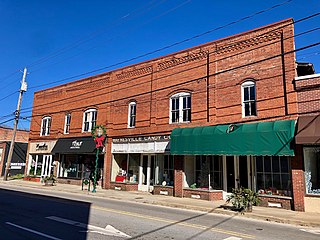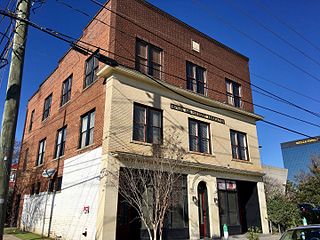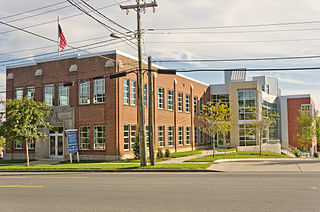
The Metropolitan Life North Building, now known as Eleven Madison, is a 30-story art deco skyscraper in the Flatiron District adjacent to Madison Square Park in Manhattan, New York City, at 11-25 Madison Avenue. The building is bordered by East 24th Street, Madison Avenue, East 25th Street and Park Avenue South, and was formerly connected by a sky bridge and tunnel to the Metropolitan Life Insurance Company Tower just south of it.

The Occidental Life Building is a historic office building in Albuquerque, New Mexico, in the United States. Featuring an unusual Venetian Gothic Revival architectural style inspired by the Doge's Palace in Venice, the building is one of the city's most recognizable landmarks and has been described as "unique in the country".

Village District, was the first planned community to be developed in Raleigh, North Carolina. Development was started in 1947 when J.W. York and R.A Bryan bought 158 acres (64 ha) of undeveloped land two miles west of downtown Raleigh, near the North Carolina State University campus. The "village" was to consist of a shopping center, apartments, and single family homes. The area was renamed to Village District in 2021 to distance itself from the slave owning Cameron family, who owned Stagville Plantation, that it was originally named after.

The Old North Carolina Mutual Life Insurance Company Building, also known as the Mechanics and Farmers Bank Building, is an office building at 114-116 West Parrish Street in downtown Durham, North Carolina. It formerly served as the headquarters for the North Carolina Mutual Life Insurance Company, which was formerly one of the nation's largest companies founded and owned by African-Americans. The building was declared a National Historic Landmark in 1975.

The Jefferson Standard Building is a 374 ft (114m) skyscraper in Greensboro, North Carolina. It was completed in 1923 as the headquarters for Jefferson Standard Life Insurance Co. and has 18 floors. Until it was superseded by the Nissen Building in Winston-Salem in 1927, it was the tallest building in North Carolina and the tallest building between Washington, D.C., and Atlanta, Georgia. It was named to the National Register of Historic Places in 1976.

The Frog Level Historic District is a national historic district located in the Frog Level neighborhood at Waynesville, Haywood County, North Carolina. It includes 16 contributing buildings and one other contributing structure in the neighborhood of Frog Level. It includes Early Commercial architecture and Romanesque architecture. The buildings are predominantly one and two-story brick or frame buildings dating from the first three decades of the 20th century. Notable buildings include the C. G. Logan Auto Company, the Medford Furniture Company (1912), the T. N. Massie & Son building, and the North Carolina National Guard Armory (1936).

Halifax Historic District is a national historic district located at Halifax, Halifax County, North Carolina, US that was listed on the National Register of Historic Places in 1970. It includes several buildings that are individually listed on the National Register. Halifax was the site of the signing of the Halifax Resolves on April 12, 1776, a set of resolutions of the North Carolina Provincial Congress which led to the United States Declaration of Independence gaining the support of North Carolina's delegates to the Second Continental Congress in that year.

North Carolina Mutual Building, also known as the Blue Palace Tea Shop and Barber Shop, is a historic commercial building located at Columbia, South Carolina. It was built in 1909 by the North Carolina Mutual Life Insurance Company, and is a three-story, rectangular, brick commercial block. The building housed African-American businesses, professionals, and institutions during the years of Jim Crow segregation. It is located in the Washington Street business district, the city's black downtown.

Biltmore Hospital, also known as the Biltmore Hospital Extension and Memorial Mission Hospital, is a historic hospital building located at Biltmore Village, Asheville, Buncombe County, North Carolina. It was built in 1929–1930, and originally known as the Battle Wing to the Clarence Barker Memorial Hospital. It is a four-story, 13 bay by 3 bay, brick and stone building with a flat roof and Tudor Revival style design elements. A two-story wing was completed in 1953 for the Imperial Life Insurance Company. Also on the property are contributing culverts and a sign.

Fayetteville Mutual Insurance Company Building, also known as the Point News building, is a historic commercial building located at Fayetteville, Cumberland County, North Carolina. It was built about 1853, and is a two-story trapezoidal-shaped Greek Revival style brick building.

Downtown Greensboro Historic District is a national historic district located at Greensboro, Guilford County, North Carolina. When first listed, the district encompassed 96 contributing buildings in the central business district of Greensboro. The commercial buildings were built between about 1885 and the 1930s in a variety of popular architectural styles including Italianate and Art Deco. Located in the district is the separately listed Jefferson Standard Building. Other notable buildings include the Vanstory Building, Kress Building (1929), Woolworth's, Efrid's Department Store, Montgomery Ward (1936), the Carolina Theatre (1927), Center Theatre (1948), the former Belk Building (1939), Ellis Stone/Thalhimer's Department Store (1949-1950), and the former American Exchange National Bank Building (1920). The Woolworth's store is notable as the site of the Greensboro sit-ins of 1960.

Ahoskie Historic District is a national historic district located at Ahoskie, Hertford County, North Carolina. The district encompasses 604 contributing buildings, 1 contributing site, and 2 contributing structures in the central business district and surrounding residential sections of Ahoskie. The buildings include notable examples of Classical Revival, Colonial Revival, Late Gothic Revival, Tudor Revival, and Bungalow / American Craftsman architecture. The district includes the separately listed Ahoskie School and Roberts H. Jernigan House and encompasses the previously listed Ahoskie Downtown Historic District. Other notable buildings include The Tomahawk Motel, Ahoskie Food Center, Thomas Wright Hayes House, Basnight & Company Building, Ahoskie United Methodist Church, St. Thomas Episcopal Church, and North Carolina Mutual Insurance Company.

Grinnell Company-General Fire Extinguisher Company Complex is a historic factory complex located at Charlotte, Mecklenburg County, North Carolina. It was built in 1929–1930, and consists of a two-story office building and massive tall, one-story Grinnell manufacturing building. The office building is a reinforced concrete structure, with a brick veneer, a flat roof, and a parapet capped in concrete coping. The manufacturing building has a poured concrete slab foundation, brick veneered walls, a steel framing system consisting of I-beam piers and heavy Pratt truss roof, banks of continuous, steel sash windows, and large, sawtooth monitors. The complex was built for the largest manufacturer of automatic sprinklers and other fire protection products in North America.

Badin Historic District is a national historic district located at Badin, Stanly County, North Carolina. The district encompasses 200 contributing buildings and 8 contributing sites in the company town of Badin. They were built starting about 1912 and include residential, institutional, and commercial structures in Gothic Revival and Bungalow / American Craftsman style architecture. The community was developed by the Southern Aluminum Company of America, later Alcoa, with Badin developed for white residents. Notable buildings include the Badin Hospital, Badin Elementary School, 24 Henderson Street, 28-30 Henderson Street duplex (1914), 27-33 Boyden Street quadruplex (1913-1914), Badin Club House and Club House Annex, and Badin Baptist Church.

West Badin Historic District is a national historic district located at Badin, Stanly County, North Carolina. The district encompasses 153 contributing buildings and 4 contributing sites in the company town of Badin. They were built starting about 1912 and include residential, institutional, and commercial structures in Gothic Revival and Bungalow / American Craftsman style architecture. The community was developed by the Southern Aluminum Company of America, later Alcoa, with West Badin developed for African-American residents. Notable buildings include the houses at 704 Roosevelt Street and 417 Jackson Street, 228-226 Lincoln Avenue duplex, Baptist Church, McDonald's Chapel AME Zion Church, and Badin Colored School.

G. Milton Small and Associates Office Building is a historic home and office located on Brooks Avenue in Raleigh, Wake County, North Carolina. It was designed by architect G. Milton Small (1916-1992), who also designed the Small House, and built in 1966. It is a one floor, steel-frame Miesian style building that covers most of a 69-foot by 155-foot flat lot. It features grids of aluminum mullions carrying metal panels and sheets of glass, and an overhanging flat roof. It housed the architecture firm of G. Milton Small and Associates.

Reserve Loan Life Insurance Company is a historic commercial building located at Indianapolis, Indiana. It was built in 1924–1925, and is a four-story, Classical Revival style reinforced concrete building, with a three-story, white marble temple front. It features Corinthian order columns. The building was rehabilitated in 1987. Additional stories were added later and the building converted to a condominium complex.

The American Republic Insurance Company Headquarters Building is a historic building located in downtown Des Moines, Iowa, United States. It was completed in 1965 for the insurance company's headquarters and it continues to serve that purpose. It was listed on the National Register of Historic Places in 2015.

The Flynn–Griffin Building, also known as the Flynn Block, Peoples' Savings Bank Building, and the Edna M. Griffin Building, is a historic building located in Des Moines, Iowa, United States. It was listed on the National Register of Historic Places in 2016.
Pilot Life Insurance Company Home Office in Sedgefield, North Carolina outside Greensboro is a historic campus which once served as the headquarters of Pilot Life Insurance Company, founded in 1903 and merged with Jefferson Standard Insurance in 1967 to form Jefferson Pilot Corporation. It was named to the National Register of Historic Places in July 2022.























